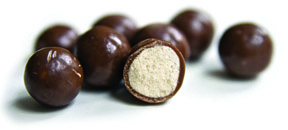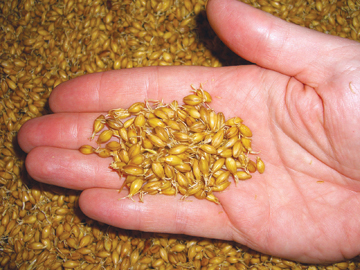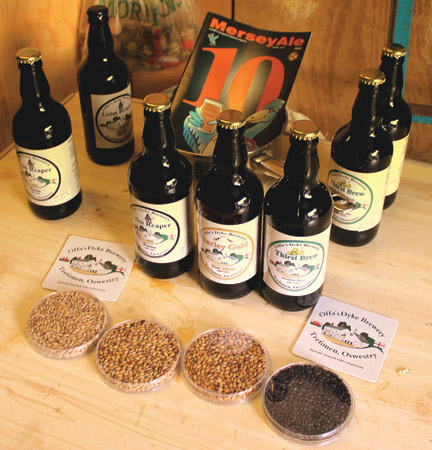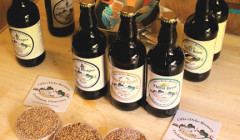The Magic is in the Malt
As a child, I couldn’t get enough of those Whoppers chocolate milk balls or malted milkshakes. Perhaps the natural progression to loving beer had something to do with a specific ingredient they all have in common: barley malt. One of the four essential ingredients in beer, barley malt (also known as “malt”) is a cereal grain used in making  beverages (e.g. malt whiskey, beer, Latin American malta) and sweetening foods. As with other cereal grains, there are different varieties of malt; some are used specifically in beer.
beverages (e.g. malt whiskey, beer, Latin American malta) and sweetening foods. As with other cereal grains, there are different varieties of malt; some are used specifically in beer.
While hops and their characteristics are usually at the forefront of craft beer discussions, barley malt is extremely important (and necessary) in making that delicious libation you crave and enjoy. So what exactly is it and why is it essential? Barley malt provides enzymes, starches, sweetness, flavor, foam, body and color to that light lager, amber ale, stout and all the beers in the world. It also balances that hop bitterness that some of us love and others not so much.
 Basically, barley malt is barley that’s been soaked in water up to the germination point and then dried with hot air in a kiln before they sprout. The kernels have bursted with enzymatic reactions; the heating stops the kernel from sprouting and halts the starch-to-sugar conversion. The end product is malted barley.
Basically, barley malt is barley that’s been soaked in water up to the germination point and then dried with hot air in a kiln before they sprout. The kernels have bursted with enzymatic reactions; the heating stops the kernel from sprouting and halts the starch-to-sugar conversion. The end product is malted barley.
How do brewers choose which malts to use? In brewing, two kinds of barley are used for making malt: six-row (barley with six rows of kernels on the stalk) and two-row (two rows of kernels on the stalk). Generally speaking, six-row has less starch and more protein. Larger commercial breweries prefer the six-row while craft brewers lean towards the two-row for its thinner husk, which keeps a certain amount of protein and enzyme content. Other grains (such as oats and wheat) are also used in conjunction with barley malt to add another dimension of aroma, flavor, body and appearance. Wheat beers such as hefeweizens and Belgian wits have distinctive characteristics when compared with barley malt only beers.
 As with the many varieties of hops, there are different types of barley malt that brewers choose to achieve a specific color, aroma and flavor profile for their beers. Base, Specialty, Caramel and Roasted malts are all used to produce fine beers that are enjoyed all over the world. Base malts are used in virtually all beers – domestic two-row pale and English pale malts are examples. Specialty malts are those heated at higher temperatures and toast the malt after drying. The result is darker colored malt. Copper and amber colored beers that are sweeter are the result of these malts, such as Vienna, Munich, and Biscuit malts. Caramel or Crystal malts are heated while still moist which leads to a beer copper to red in color, with a greater body and flavors of caramel or sweet toffee. Examples are English Crystal and Belgian Caravienne malts. Roasted malts are those that are heated at very high temperatures and are typically used in small quantities for the sole purpose of adding deep, dark color and a roasted or burnt charcoal flavor to the beer. Examples include Chocolate and Black Patent malts.
As with the many varieties of hops, there are different types of barley malt that brewers choose to achieve a specific color, aroma and flavor profile for their beers. Base, Specialty, Caramel and Roasted malts are all used to produce fine beers that are enjoyed all over the world. Base malts are used in virtually all beers – domestic two-row pale and English pale malts are examples. Specialty malts are those heated at higher temperatures and toast the malt after drying. The result is darker colored malt. Copper and amber colored beers that are sweeter are the result of these malts, such as Vienna, Munich, and Biscuit malts. Caramel or Crystal malts are heated while still moist which leads to a beer copper to red in color, with a greater body and flavors of caramel or sweet toffee. Examples are English Crystal and Belgian Caravienne malts. Roasted malts are those that are heated at very high temperatures and are typically used in small quantities for the sole purpose of adding deep, dark color and a roasted or burnt charcoal flavor to the beer. Examples include Chocolate and Black Patent malts.
When tasting beer, some drinkers may think that the darker the beer, the heavier. Sometimes the colors don’t aren’t always an indicator of what you think you’re going to taste. Take for example the black lager. While very dark in color, it has a light body and a taste you might not expect. Will you remember all about malts when you taste your beer? Probably not. It’s my hope that the next time you enjoy those sips, that you take a good look at your glass, look at it in different lights (literally and figuratively) and take notice of the color, foam, and taste how sweet it is or isn’t. How does it balance out the hops? Is your beer hoppy or malty? Which kinds of flavors do you prefer? It’s so easy to focus on a beer’s bitterness; it’s just as easy to take note of its maltiness too. Take mental note of the contribution that malt makes, milkshakes and all. Cheers!










